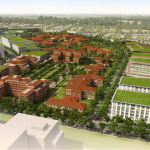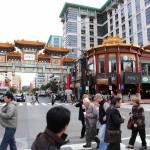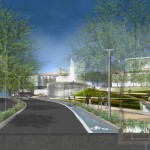A few weeks ago, we announced the eight cities and 11 districts that comprise our Target Cities pilot program. These projects are pushing the limits of district-scale sustainability and helping us test and refine the EcoDistricts Protocol.
We’re particularly excited to be hosting the 2014 EcoDistricts Summit in Washington, DC, because with threeTarget Cities projects underway, DC provides an unparalleled opportunity to explore the range of communities and issues that Target Cities addresses.
To get you primed for the Summit, here’s a quick profile of these next-generation projects.
Three DC Sustainable Development Districts
The Target Cities program builds upon previous planning and development in Oxon Run Creek, Oxon Run Park, the St. Elizabeths East campus, the Martin Luther King Jr. Avenue SE commercial corridor, and portions of the

Congress Heights neighborhood. This work will support citywide sustainability efforts in stormwater and energy management, health and wellness, neighborhood revitalization, and resource sharing. The Office of Planning (OP) will lead a multi-agency effort with the Office of the Deputy Mayor for Planning and Economic Development (DMPED), the District Department of the Environment (DDOE), the Department of General Services (DGS) and the District Department of Transportation (DDOT) to advance the project’s goals and deploy innovative solutions.
The SW Ecodistrict Initiative is a comprehensive and forward-looking approach to urban sustainability and livability in the heart of Washington, DC. The vision proposes transforming a 15-block, predominantly federal precinct located just south of the National Mall into a highly sustainable, walkable neighborhood and workplace that will:
connect the National Mall with Washington’s southwest waterfront; be a national showcase of sustainable urban development; and provide sites for major new museums, memorials, and events; accommodate the federal government’s future space needs; and include housing, commercial services and usable open space.
DowntownDC Ecodistrict: Created in 1997 by way of legislation, the DowntownDC Business Improvement District is focused on investing in capital improvements and providing services, resources and research to enhance the experience and improve the quality of life of workers, residents, visitors and the like as they explore all that the downtown Washington, D.C. neighborhood has to offer. Business owners approved a self-imposed tax that generates approximately $11 million annually to makeup the BID’s annual operating budget. The BID identified three primary goals for the district-scale project:
- Reduce resource consumption
- Increase market competitiveness
- Enhance economic performance
 With a perfect storm of access to public resources, market opportunities, legislative mandates and economic drivers in Washington D.C., the DowntownDC Ecodistrict is well positioned to meet and surpass thresholds set by the Department of Energy’s Better Buildings Challenge to reduce energy consumption by 20% by 2020. This is a significant reduction that will benefit the entire city, since the built environment is responsible for 75% of the GHG emissions in the city and the DowntownDC Ecodistrict accounts for 38% of the total private and government office spaces in the city and includes the Convention Center, Verizon Center and other major consumers of energy.
With a perfect storm of access to public resources, market opportunities, legislative mandates and economic drivers in Washington D.C., the DowntownDC Ecodistrict is well positioned to meet and surpass thresholds set by the Department of Energy’s Better Buildings Challenge to reduce energy consumption by 20% by 2020. This is a significant reduction that will benefit the entire city, since the built environment is responsible for 75% of the GHG emissions in the city and the DowntownDC Ecodistrict accounts for 38% of the total private and government office spaces in the city and includes the Convention Center, Verizon Center and other major consumers of energy.


